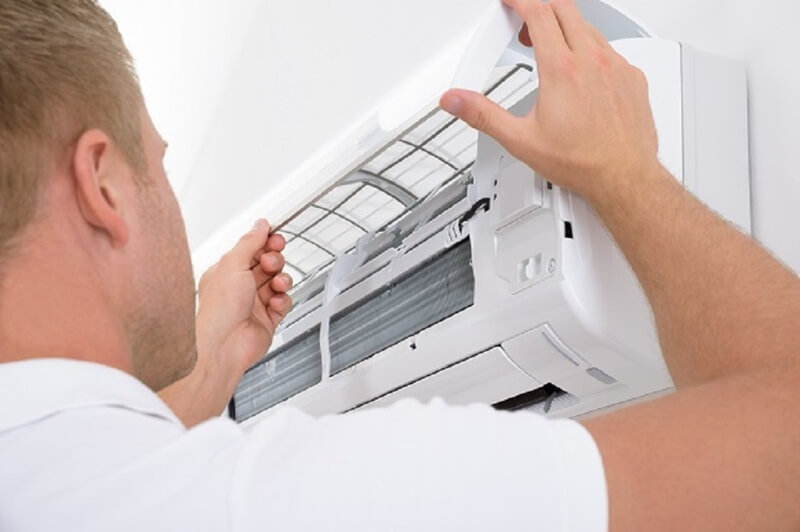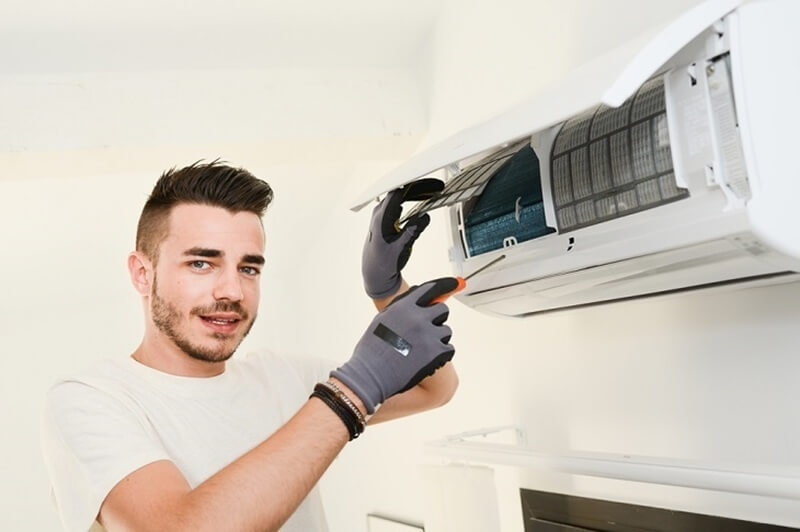Ever had the feeling that your small bedroom turns into a sauna during those scorching summer nights in Australia? Tired of tossing and turning as you tried
desperately to find that perfect cool spot on your pillow? What if you could change your small living area into a refreshing oasis without breaking the bank or compromising much square metres?
Choosing the appropriate cooling system for small spaces is not just about purchasing the cheapest one from the market. It’s about understanding what your particular requirements are, then maximising the efficiency of unit and choice to keep you comfortable all-year round. Be it a small studio in Sydney, a converted spare room in Melbourne, or a granny flat in Brisbane, this guide will help you through the maze of small-space cooling solutions.
We’ll cover everything, from the basics of understanding air conditioning input and output to cracking the energy ratings that really do affect your power bill. You’ll learn about different kinds of units that are highly suitable for small spaces, plus money-saving tips, and where money could be wasted with common mistakes. Let’s get started right away on your perfect cooling companion!
What Is An Air Conditioner and How Does It Work in Compact Areas?

Input and Output of Air Conditioner
In a nutshell, an air-conditioning device or unit is a heat pump that pumps out warm air from within your room to the atmosphere outside. It’s a one-way thermal conveyor belt, that absorbs warm indoor air (that’s your input) passes it over cold coils filled with refrigerant, and of course, it throws out heat from the outside while sending cooled air back into your room (that’s your output).
This is particularly interesting in small spaces, because an air conditioner doesn’t really make cold. It removes heat and moisture. The refrigerant pulls the heat out from your indoor air into an outdoor unit, where it ‘throws’ the heat, then returns to start anew. This is then continuously circulating through the system, keeping your area comfortable-but in compact areas, this circulatory efficiency is crucial.
Cool small spaces conserve a lot of energy. Your unit will not have to struggle to hold the occupancy temperatures, thus saving the energy consumption and increasing the lifespan of the equipment. However, sizing becomes critical: too big and you’ll waste energy; too small and you’ll never achieve comfort.
How The Physics Works in Cooling a Small Space
Cooling power in small rooms follows some really fascinating physics. Air circulation patterns created in smaller spaces make for interesting challenges and opportunities. Hot air rises, while cool air sinks; in fact, convection currents might either enhance your efforts to cool or hinder them.
These air currents can work to your advantage in very small bedrooms or studio apartments. The limited volume means your air conditioner will be able to affect a complete air change far more frequently, so your temperatures will be more consistent throughout the entire space. That’s why, to most people’s perception, a properly sized unit for a small room performs better than an oversized unit struggling to cool a massive open plan area.
Temperature stratification becomes much less of a problem in smaller spaces as well, those annoying hot and cold spots. The distance that the air has to travel is smaller relative to the number of obstacles in the way, such as furniture arrangements, meaning you’re highly likely to achieve that Goldilocks zone of perfect comfort throughout your entire room.
Real Operating Costs of Air Conditioners: Their Power Consumption
Learning About Your Aircon Power Rating
Your air conditioner power rating tells you how much electricity it buys per hour, using the measure kilowatts (kW). Don’t confuse this with cooling capacity-three kW cooling capacity unit may need only 0.7 kW to run, thanks to improvements in efficiencies. This relationship is called Coefficient of Performance.
To calculate the real consumption, look for the ‘Power Input’ or ‘Rated Power Consumption’ line in the unit specifications. This number has to be multiplied by the hours of usage and rate of electricity to give you real running costs. A unit with power consumption of 0.7 kW working for 5 hours at 30 cents a kWh would cost $1.05 per day.
Even peak demand charges dramatically affect prices. If you run your air conditioner in peak hours (2 p.m.-8 p.m. weekdays generally), it can cost up to twice or more what it costs during off-peak periods. By running your unit smartly around these peak periods, you can cut those bills by an impressive amount while still enjoying comfort.
Calculating Daily and Monthly Energy Usage
Now, let us take a look at some real calculations for a standard small bedroom setup. A 2.5-kW inverter split system with a 4-star rating uses about 0.65kWh. Eight hours of nighttime operation at 28 cents per kWh will cost $1.46 per day or $43.68 per month in summer. Not so bad for comfort guaranteed!
But patterns of usage change things altogether. The same unit would cost $131 every month on constant operation-a steep rise! This is where the beauty of programmable timers and smart controls comes in: set your unit to start cooling 30 minutes before your bedtime and stop operating after 4 hours. This way, you can halve your consumption while being still comfortable.
Another thing to consider is the seasonal variation. Melbourne may require cooling for 90 days in a year; while, for Darwin, it can go well over 300 days. Your annual cost can vary from $130 to $430 for the same energy during the same usage pattern based on geography.
Peak Vs Off-Peak Usage with AGL Air Conditioning Plans
Such time-of-use tariff energy retailers from AGL could affect the amount spent on air conditioning. For example, the peak rate may go up to as much as 40 cents per kWh while off-peak rates are as low as 15 cents per kWh. These dips can bring about some serious savings every year if your use is tailored around their time frames.
Pre-cool your space during the off-peak afternoon hours and hold the temperature during peak times whereby less energy is consumed overall. Since your well-insulated small space holds temperature better than larger areas, this particular approach is the most fitting.
Certain retailers also provide specific controlled-load tariff arrangements for fixed installations of air conditioning. This means you receive a discounted rate for allowing the local utility to cycle your unit on and off be-tween others during periods of peak demand. These types of schemes are quite worthy for cooling bedrooms where being interrupted by small increments during the short hours of sleep will hardly be heard.
Air Conditioner Efficiency Tips For Maximum Cooling

Temperature Settings Best for Australian Summer Heat
For hot-weather summertime air cooling in Australia, 24 to 25°C is the ideal. Any reduction in that will increase energy consumption by 8-10% for each degree. Setting the room temperature to 20°C won’t make it cooler any faster – it just means the unit will have to run longer, and therefore longer waste of energy and money.
Environmental temperatures match up after a while. Begin training the body, take the summer to be at around 26 degrees Celsius and progressively lower it to 24 degrees when it gets hotter, so as not to compromise comfort while saving energy. The settings can easily move up to 26-27°C at night since the burning of metabolism slows during sleep.
On humid days, the “dry” or “dehumidification” mode is very useful. Drying up the moisture makes 26°C feel like 23°C, a recipe for comfort without spending much on cooling. This avenue is especially successful in coastal areas, where humidity is far worse than temperature.
Maintenance For Better Air Conditioner Performance
The air conditioner’s simplest maintenance to guarantee efficiency and performance is clean filters. Dirty filters will make the unit work extra hard, pushing up the energy consumption by as much as 15%. Clean the filters every 2 weeks in dusty environments or heavy usage. It takes 5 minutes and saves a lot of cash.
Carry out annual professional servicing for optimal performance of your system. Technicians inspect refrigerant levels, clean coils, and fix any other problems detected before they morph into expensive failures. A unit in good condition will survive longer and remain energy-efficient throughout its lifecycle.
Lastly, don’t forget to maintain the outdoor unit on the split system. Trim back vegetation at least 60cm, get rid of all dirt and keep hosing dust and leaves lightly. Prevention of good airflow around the outdoor unit improves heat rejection thereby reducing power consumption up to 10%.
Use Fans So Air Conditioning May Power Up
Ceiling or pedestal fans are allies of your air conditions. The moving air feels 3-4 degrees cooler than still air; thus, you can raise the thermostat settings while remaining comfortable. While the fan needs just 50 watts, air conditioning uses 700 watts up.
Direct fans to circulate in patterns harmonizing with the cool air coming from your air conditioner. In small rooms, one fan can aid in distributing cooled air equally so that there are no hot spots that force lower temperature settings.
During the cooler weather, you may find a fan sufficient. On those scorching summer days in Brisbane, though, a fan combined with the natural breeze will keep you cool on an air-conditioning day. Save your dear unit for those hot afternoons when a fan just won’t cut it.
Stay Cool and Stay Thrifty
Choosing the right AC for your small room seems like a task nobody would want to dive into, but now you can select one after keeping comfort, efficiency-inspired elements, and prices in mind.
So get the one that suits your room, pocket, and style of living; one that is neither too small nor too big, but at the same time works like a charm saving you a pretty penny with operational costs. Spend some time considering real costing and weighing the long-term benefits versus short-term investments needed for installation.
Big comfort for your small space without burning up a hole in the pocket; this can be done with the right thinking. Start with the measurement, put the efficiency rating first, and don’t forget the little things like use of fans and maintenance of temperatures. Here’s praying for a cooler, more comfortable summer season in your small space, now adequately controlled!







